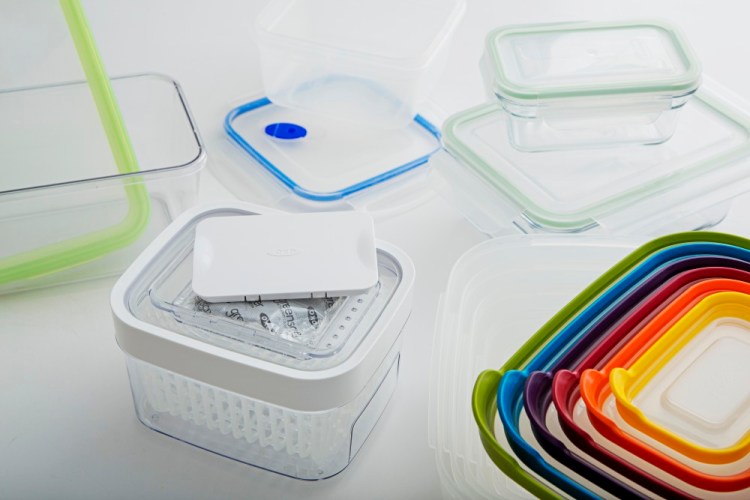Until we all started taking our own reusable bags to the grocery store, there was the inevitable question at the checkout lane: paper or plastic?
Now there’s still at least one material question to consider once we get that food home and start cooking, eating and storing it: glass or plastic?
If you’re like me, at least one of your kitchen cabinets is overflowing with an assortment of containers intended for storing leftovers. A lot of them have come via takeout food or goodies my mom has sent home with me. Occasionally I’m tempted to cull the herd and pick up a few new workhorses that aren’t stained, cloudy or missing lids.
But where to start?
Because the number of options can be overwhelming, employees at the Container Store are trained to ask customers a series of questions, says Kim Kimbriel, a buyer for the national chain.
Think about who’s going to be using the containers and what they’ll be using them for, Kimbriel says. Kids taking lunch to school? Plastic. Mom storing food in the freezer for oven-ready meals? Glass. “There’s a trend that we see that people are really loving glass as an option,” she says.
“Generally, glass is the most airtight,” says Sharon Franke, kitchen appliances and technology director for the Good Housekeeping Institute in New York.
Good Housekeeping recently published its “best of the best” on food storage, with Frieling’s Emsa Clip & Close containers coming out on top. They kept air out for 14 days, which Franke and her team tested in a hot and humid climatology lab using silica gel beads that change from blue to pink when exposed to moisture. (For the record, even inexpensive disposable plastic containers performed respectably for about a week.)
Franke says containers with silicone gaskets and lids that snap on all four sides are especially effective at keeping food fresh.
There have been other user-friendly developments in food storage. Many manufacturers no longer make plastics with bisphenol-A (BPA), the controversial chemical that has been linked to possible health risks, even though the U.S. Food and Drug Administration considers it safe. And in light of the ongoing conversation about food waste, companies are exploring new ways to help consumers hold onto their produce longer. Oxo’s GreenSaver products, for example, feature activated carbon filters, “floating” baskets and adjustable vents that are designed to, respectively, trap ethylene gas (which causes some produce to decay), promote airflow and control humidity.
Kimbriel says container materials also have expanded beyond glass and plastic to include stainless steel and silicone. The Container Store sells a line of silicone containers that are microwave- and oven-safe.
Some silicone containers collapse for easy storage. Another organizing solution: sets with nesting containers and lids, such as Joseph Joseph’s Nest Food Storage collection. Other brands feature lids that snap onto the bottom of containers, such as Snapware Airtight, which Cook’s Illustrated highly recommended in its rigorous testing of plastic food storage containers in 2010. No more mismatched sets or cascades of tumbling plastic.
The shape of the container is another factor to consider. Most people gravitate toward rectangular pieces, Kimbriel says, as they’re easier to store and optimize available space. The depth of the containers is important as well. Cook’s Illustrated noted that low, flat versions make it easy to stack items above or below them. The magazine added that shallower containers also facilitate quick cooling, to get food out of the temperature danger zone where bacteria can thrive (40 to 140 degrees), as well as heating, which means dinner can get on the table that much faster.
Whatever you end up buying, follow the manufacturer’s care instructions. Most plastics belong on the top rack of your dishwasher, if you put them there at all. “I’m an advocate of hand-washing things,” Kimbriel says.
Sometimes you might not need to bother with a container. Franke says food companies have worked on packaging that keeps their food fresher. A good clip might be all you need to close a bag of coffee or chips, she says.
Send questions/comments to the editors.



Success. Please wait for the page to reload. If the page does not reload within 5 seconds, please refresh the page.
Enter your email and password to access comments.
Hi, to comment on stories you must . This profile is in addition to your subscription and website login.
Already have a commenting profile? .
Invalid username/password.
Please check your email to confirm and complete your registration.
Only subscribers are eligible to post comments. Please subscribe or login first for digital access. Here’s why.
Use the form below to reset your password. When you've submitted your account email, we will send an email with a reset code.